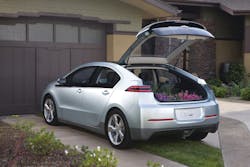SUBJECT: Electric Vehicles
TOPIC: Part 1 — 2011 Chevrolet VOLT
OBJECTIVE: Given a potential scenario involving a 2011 Chevrolet VOLT, the emergency responder team will be able describe their actions to effectively manage the situation.
TASK: The rescue team shall study the 2011 Chevrolet VOLT information provided along with conducting a tour and inspection of an actual vehicle at a Chevrolet dealership to adequately plan on procedures necessary for managing any of a variety of possible scenarios involving a 2011 Chevrolet VOLT.
By the fall of 2010, the Chevrolet Division of General Motors will be delivering the first Chevrolet VOLT vehicles to dealerships in several states across the country. GM intends to build 10,000 cars in 2011 and 30,000 in 2012. GM plans to sell VOLTs in all 50 states by 2012, or between 12 and 18 months after launch. This vehicle is not a conventional vehicle. It is the first of three new all-electric drive vehicles that we will discuss in this multi-part series.
The 2011 Chevrolet VOLT is a four-door, four-passenger hatchback vehicle. Although the exterior appears normal and very stylish, it is what lies beneath the surface that emergency responders will be most interested in. The Chevrolet VOLT is actually referred to as an extended range, plug-in electric vehicle. That's a nice description, but what does it mean? Let me explain.
The VOLT is essentially a midsize passenger vehicle built exclusively to be powered not by a gasoline engine, but by a 400-pound, 360-volt lithium-ion battery. Unlike the gasoline-electric hybrids that we have become somewhat familiar with, all motion of the VOLT comes from electric power provided by this battery pack directly to the front drive wheels. Although there is a gasoline motor onboard, it is just an electric generator that only recharges the high-voltage battery when needed. This generator never powers the drive wheels.
The unique aspect of the VOLT is that it is a plug-in vehicle, not a gasoline-electric hybrid vehicle. Owners can travel a distance of up to 40 miles on the one charge. Once at home in their garage, for example, they would then take the special extension cord and plug the VOLT into a 120-volt or 240-volt electrical outlet. The lithium-ion battery will recharge in three to four hours on a 240-volt circuit; eight hour recharge time on a 120-volt circuit.
If a commuter owns a VOLT and drives less than 40 miles roundtrip back and forth to work, they would essentially have a zero-emission vehicle that would never use gasoline. When that same owner drives their VOLT a distance of more than 40 miles in one trip, the onboard generator starts up and recharges the high-voltage battery. The generator runs off an eight-gallon gasoline tank and provides a driving range of approximately 400 additional miles.
In addition to the 360-volt DC battery, there is a typical 12-volt electrical system. The battery for this more familiar system is a standard lead-acid battery and is located beneath the floor in the rear cargo area of the hatchback vehicle.
Through this multi-part series of University of Extrication columns, we will explore the intricate features of the VOLT from an emergency responder perspective, covering vehicle construction and design, operating features and battery information and providing recommendations for rescue and extrication protocols for the VOLT.
The scenarios that will be addressed include a:
• Lockout/vehicle unlock scenario
• Disabled vehicle; jump start, need tow, etc.
• Vehicle fire; engine compartment, passenger compartment, 360-volt battery fire
• Collision scenarios including injuries and/or entrapment
• Submersion scenario
TASK: The rescue team shall study the 2011 Chevrolet VOLT information provided along with a conducting a tour and inspection of an actual vehicle at a Chevrolet dealership to adequately plan on procedures necessary for managing any of a variety of possible scenarios involving a 2011 Chevrolet VOLT.
Read the rest of the series here:
RON MOORE, a Firehouse® contributing editor, is training chief for the McKinney, TX, Fire Department. He also authors a monthly online article in the Firehouse.com "MembersZone" and serves as the Forum Moderator for the extrication section of the Firehouse.com website. Moore can be contacted directly at [email protected].

Ron Moore
RON MOORE, who is a Firehouse contributing editor, recently retired as a division chief with the McKinney, TX, Fire Department and now serves with Prosper, TX, Fire Rescue. He self-published the Vehicle Rescue 1-2-3 training manual and serves as the forum moderator for the extrication section of Firehouse.com . Moore can be contacted directly at [email protected].






